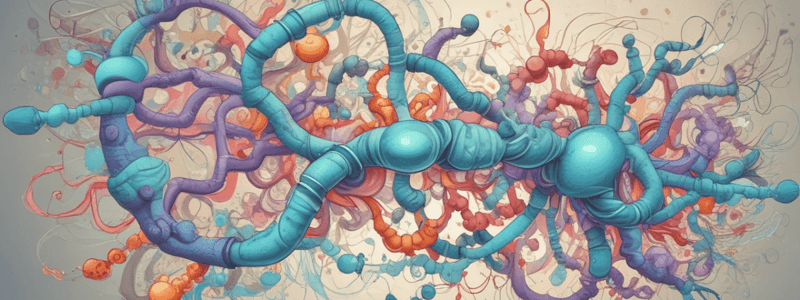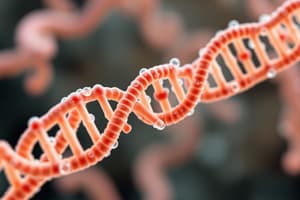Podcast
Questions and Answers
What is the primary function of the spliceosome?
What is the primary function of the spliceosome?
- To modify nucleotides to change the amino acid sequence
- To add a poly(A) tail to the 3' end of pre-mRNA
- To remove introns and join exons in pre-mRNA (correct)
- To transcribe DNA into pre-mRNA
What is the function of the U1 snRNP in the spliceosome?
What is the function of the U1 snRNP in the spliceosome?
- To catalyze transesterification reactions
- To bind to the AG motif at the 3' splice site
- To add a 7-methylguanosine cap to the 5' end of pre-mRNA
- To bind to the GU motif at the 5' splice site (correct)
What is the purpose of capping in mRNA maturation?
What is the purpose of capping in mRNA maturation?
- To remove introns and join exons in pre-mRNA
- To modify nucleotides to change the amino acid sequence
- To protect the 5' end of pre-mRNA from degradation (correct)
- To add a poly(A) tail to the 3' end of pre-mRNA
What is the outcome of alternative splicing?
What is the outcome of alternative splicing?
What defines the exon-intron boundary?
What defines the exon-intron boundary?
What is the outcome of intron removal and exon joining?
What is the outcome of intron removal and exon joining?
What is a common characteristic shared by tRNA introns?
What is a common characteristic shared by tRNA introns?
What is a key difference between introns in mRNA and tRNA?
What is a key difference between introns in mRNA and tRNA?
What is the function of the conserved sequences at the 5' and 3' ends of introns?
What is the function of the conserved sequences at the 5' and 3' ends of introns?
What is a characteristic of the consensus sequence in introns?
What is a characteristic of the consensus sequence in introns?
What is the typical sequence found at the 5' end of introns?
What is the typical sequence found at the 5' end of introns?
What is the typical sequence found at the 3' end of introns?
What is the typical sequence found at the 3' end of introns?
What is the significance of the branching point in introns?
What is the significance of the branching point in introns?
What is the significance of the G nucleotide at the exon-intron boundary?
What is the significance of the G nucleotide at the exon-intron boundary?
What is the position of the branching point in the intron?
What is the position of the branching point in the intron?
What is the significance of the GU and AG consensus sequences in introns?
What is the significance of the GU and AG consensus sequences in introns?
What is the significance of the variable length of the central part of the RNA?
What is the significance of the variable length of the central part of the RNA?
What is the role of the 2'OH group in the reaction of intron excision?
What is the role of the 2'OH group in the reaction of intron excision?
Why does the reaction of intron excision occur only in RNA and not in DNA?
Why does the reaction of intron excision occur only in RNA and not in DNA?
What is the consequence of the second nucleophilic attack in the intron excision reaction?
What is the consequence of the second nucleophilic attack in the intron excision reaction?
What is the role of the U-snRNAs in the intron excision reaction?
What is the role of the U-snRNAs in the intron excision reaction?
What is the significance of the consensus sequence in the RNA?
What is the significance of the consensus sequence in the RNA?
What is the structure formed by the adenine and the intron during the reaction?
What is the structure formed by the adenine and the intron during the reaction?
What is the difference between the first and second nucleophilic attacks in the intron excision reaction?
What is the difference between the first and second nucleophilic attacks in the intron excision reaction?
What is the significance of the autocatalytic intron in mitochondria?
What is the significance of the autocatalytic intron in mitochondria?
What is the outcome of the intron excision reaction?
What is the outcome of the intron excision reaction?
Flashcards are hidden until you start studying
Study Notes
Spliceosome Function
- The spliceosome is a large ribonucleoprotein complex responsible for removing introns and joining exons in pre-mRNA
- Composed of 5 snRNPs (small nuclear ribonucleoproteins) and over 100 proteins
- Catalyzes two transesterification reactions to form a lariat structure and release the intron
- Leaves a continuous mature mRNA molecule
GU-AG Recognition
- The spliceosome recognizes the GU-AG motif at the intron-exon boundaries
- GU at the 5' splice site and AG at the 3' splice site
- The U1 snRNP binds to the GU motif, and the U2 snRNP binds to the AG motif
- This recognition is crucial for the spliceosome to accurately remove introns and join exons
mRNA Maturation
- After transcription, the pre-mRNA undergoes several processing steps to mature into functional mRNA
- These steps include:
- Splicing: removal of introns and joining of exons
- Capping: addition of a 7-methylguanosine cap to the 5' end
- Polyadenylation: addition of a poly(A) tail to the 3' end
- Editing: modification of nucleotides to change the amino acid sequence
Alternative Splicing
- The process by which different exons are included or excluded to produce multiple isoforms of mRNA from a single gene
- Allows for the generation of different protein isoforms with varying functions
- Regulated by various factors, including:
- Splicing factors
- Hormones
- Cellular signals
- Tissue-specific expression
Intron-Exon Definition
- Introns: non-coding regions of DNA that are removed during splicing
- Exons: coding regions of DNA that are joined together to form the mature mRNA
- The exon-intron boundary is defined by the GU-AG motif
- The spliceosome recognizes this motif to accurately remove introns and join exons
Studying That Suits You
Use AI to generate personalized quizzes and flashcards to suit your learning preferences.




